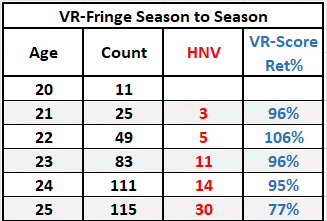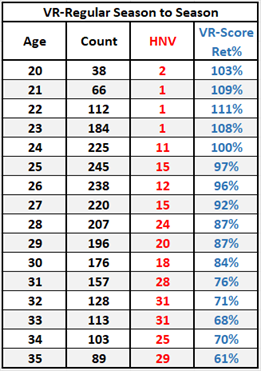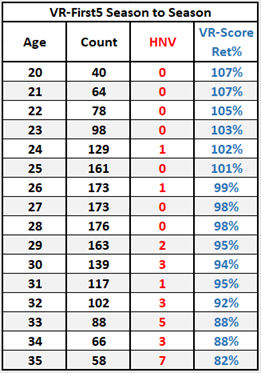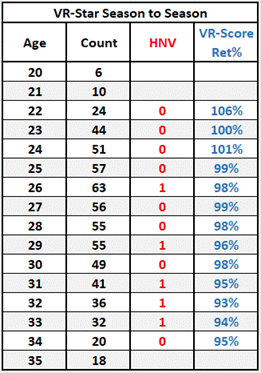When does a player hit his career peak? This is a good piece of information to know if you are considering signing a player to a long-term contract: is the player likely to get better in the next few years, will be perform at his current level, or will he start to decline? If he’s likely to decline, by how much will he decline?
Defining Career Peak
Career peak is the age at which a player hits his highest value. Obviously, individual players hit their peak at different ages, so I’ll establish the average age for groups of players. I’ll be using Value Rating (VR) for my “unit of measurement.” For more information on VR, please read the Introduction to Value Rating article (and for additional information, you could read the Introduction to Productivity Rating article as well).
VR is based on three seasons of data and it reduces the impact of missed games. As a result, its season-to-season variations are “gentle.”
Study Method
I’ll look at a group of players who share an age and a VR-Category, then compare their VR-Scores from that initial season to their VR-Score in the subsequent season. If the average VR-Score in the subsequent season is greater than it was in the initial season, they are in the “improving” part of their career. If the average VR-Score drops, they are in the “declining” part of their career.
The first year in which players have VR is 2008, and the last season which has a season that follows it is 2020. There are 6,663 players who qualify to be in a starting group (they had a VR in a season between 2008 and 2020).
The important metric is “VR-Score Retained Percentage”, or “VR-Score Ret%.” It is calculated by dividing the subsequent total VR-Score into the initial total VR-Score. I’ll give you a few calculations at the player level to serve as example.
Nick Leddy (D, CHI, 2013) had a VR-Score of 5.7050 and in 2014 had a VR-Score of 6.1201. He retained (6.1201/5.7050) 107% of his value. Between 2018 and 2019 his VR-Score went from 6.4554 to 5.7052, so he retained 88% of his value.
Andrej Meszaros (D, BUF, 2014) had a VR-Score of 4.0933, while in his next season he did not play enough games in to qualify for VR, which gave him a VR-Score of 0.0000. He retained 0% of his value. That’s a little harsh, because he was still playing, but he missed more than half of the scheduled games over a three-season period.
Now let’s turn our attention to the players and let them tell us when they hit the peak of their careers. The peak will be when they stop improving and start declining.
VR-CallUp
I’m not going to look at the career peak of VR-CallUp players.
The main reason is that there are very few players who get a VR-CallUp rating: you have to play more than half the games over three seasons while doing almost nothing. Zac Rinaldo, Brad Staubitz, Colton Orr, Cam Jansen: these are some of the players who have achieved a VR-CallUp rating.
Another reason is that no general manager in their right mind would sign a 30-year-old VR-CallUp player to a long contract. In place of a discussion of the future of guys like Cody McLeod, I’ll introduce the data table that will be used in the following sections.

The title indicates the VR category of the players of interest (VR-Fringe) while the two left columns show age and the number of players who were in that VR category at that age. For example, there were 111 24-year-old CR-Fringe players.
The next column, HNV (Had No VR), is the number of players who had no VR the following season. If a player had no value the season after having a VR, the most likely reason is that they played no games in the following season (if you don’t play a game in a season, you don’t qualify for VR). The other reason is that the player played so few games in the following season that they no longer qualified for the minimum number of games played.
The final column is the important one: VR-Score Retained Percentage. It is calculated by taking the sum of the VR-Scores of the subsequent season into the sum of the VR-Scores of the initial season. Players who had no value in the subsequent season count as having a VR-Score of zero.
If that number is above 100%, it indicates that the age-group of players got better in the subsequent season. If it is at 99% or 98%, it means the players maintained their value in the subsequent season (a very slight drop). If it is 97% or lower, it means the group of players declined in value.
VR-Fringe

A VR-Fringe player hits his peak at 22, and starts declining rapidly. The number of players in the HNV column is extremely high.
VR-Fringe is essentially the level of a “replacement player”. If it doesn’t look like a player at this level is going to play any better, their team will go on to give another guy a chance. That’s why so many of these players have no VR in the next season: their teams have decided they aren’t good enough for the NHL.
Chris Neil was a career VR-Fringe player. Active career VR-Fringe players are: Kyle Clifford, Matt Martin, Zack Kassian, Nicolas Deslauriers and Ryan Reaves.
How does a group of players who score 6 goals a season (Kassian scores 9 a season, a veritable Gretzky in this group) play for 10 or more seasons? They aren’t there to score, that’s why. They deliver a hit for each four minutes of ice time they get.
A selected list of VR-Fringe players from 2021 is below. They were selected based on age, by the way: the youngest, the oldest, and three others regularly spaced in age between them.

The VR-Fringe players who improve are generally young and are in the VR-Fringe category due to a technicality. Usually, their first season has a small number of games, and this lowers their VR-Score. For them, VR-Fringe is a “false negative.”
VR-Regular

A VR-Regular hits his peak at age 24 and then starts to decline. It is a gentler decline than what the VR-Fringe players experience.
There are career VR-Regulars. Marcus Johansson has had 11 VR-Regular seasons while playing for Washington, New Jersey, Boston, Buffalo, Minnesota, Seattle, and then Washington (again). Charlie Coyle (Minnesota, Boston) has been a VR-Regular 9 times.
Johansson was 27 in 2016, near the top of the VR-Regular category. Since then, he has retained about 74% of his value. He is near the bottom of the VR-Regular category in 2021.
74% might sound bad, but it’s better than average for 27-year-old VR-Regulars. 30% of the that group were out of the NHL five years later.
Below are the Big 5 statistics for selected VR-Regulars from 2021.

It is absolutely amazing that Zdeno Chara had a PR-Regular season at age 44. Sean Monahan’s season (and maybe his future) was impacted by an injury.
VR-First5

A VR-First5 player reaches his peak at age 25 and maintains that peak through age 28. The decline after age 28 is gentler than that of VR-Regulars. For example, a 34-year-old VR-First5 regular maintains 88% of his value in his subsequent season, while a 28-year-old VR-Regular maintains 87% of his value.
The number of players who have no VR in a subsequent season is lower for VR-First5 than for VR-Regulars. The count is in single digits for the entirety of the chart. For VR-Regulars, the number of players who had no VR in the next season was in double-digits from age 24 on.
Current career VR-First5 players? Jordan Staal has been a VR-First5 14 times, T.J. Oshie 13 times, Jordan Eberle 11 times, and Matt Duchene 11 times (with a single VR-Star season as well).

Jack Hughes will probably improve, and Andrew Mangiapane could improve. Taylor Hall will probably start declining next season and Duncan Keith is absolutely declining. What will happen to Johnny Hockey? That’s what makes hockey interesting!
VR-Star

VR-Star players hit their peak at age 24 and maintain it until age 30. VR-Star players have a career plateau, not a career peak.
Let me draw your attention to the HNV column. VR-Star players play: only five out of 538 players did not have a VR in the following season. That’s a HNV rate of 0.8%, compared to 1.4% for VR-First5, 10.6% for VR-Regular and 27.6% for VR-Fringe.
VR-Stars can continue to play long after they’ve hit their peak because they are declining slowly and they are declining from a high point. A VR-Star at 30 who loses 5% of his value per season could still be a VR-Star at age 33.
Ryan Suter has been a VR-Star 14 times. Anze Kopital has 13 VR-Star seasons (along with a VR-Elite). Drew Doughty and Nicholas Backstrom have 12 VR-Star seasons.
A selection of 2021 VR-Star players follows.

Aaron Ekblad has had injury issues these last two season, which is a little worrisome. John Carlson is showing no signs of slowing down. Mark Giordano is declining, but he’s 38 freaking years old, so cut him a break.
VR-Elite
There will be no data table for VR-Elite players because of a lack of numbers. There are only 56 instances of a player being a VR-Elite in these last 15 seasons: they are rare beasts.
VR-Elites probably hit their peak around age 23 or 24, and they maintain their peak probably until age 32. I say ‘probably’ because it’s unwise to make definitive statements based on age-groups that have three or four players.
Here is a little factoid that will help you understand how difficult it is to play at the Elite level over a long period of time: Sidney Crosby has the most VR-Elite seasons, at FIVE. Given he stays healthy and plays anywhere near his normal level, Connor McDavid will get his fifth VR-Elite season in 2022/2023. Mark Giordano and Brent Burns have had four VR-Elite seasons, but they are in the declining phase of their careers and will never put up another elite-level season.
I’ve been showing five selected active players in each VR-Category, but since there are only eight VR-Elite players, I’ll show them all.

Notice that six of the eight players had PR-Elite seasons last year. Marchand and Barkov would have had PR-Elite seasons if they had missed fewer games.
Five Years Later
Sankey diagrams can be used to show how a group of entities change over time, so I’ll use them to show how a group of players changed their VR-Categories over five years. For more information on Sankey diagrams, please see the article Frequently Used Charts.
The thick vertical bars represent a group of players in an age-category, while the horizontal lines show players moving from one age-category to another. The size of bars and flows are proportional to the number of players they represent.

The colour scheme in the chart is based on the rainbow hues: red (Elite), orange (Star), yellow (First5), green (Regular), blue (Fringe), purple (CallUp), grey (HNV – Had No VR). I only needed six colours for the VR-Categories, so I replaced indigo and violet with purple. Grey was added to show players who no longer had a VR.
The chart labels do not include counts to reduce clutter.
There were 176 25-year-old VR-Regulars (the big bar on the left). As they aged, some players improved and moved into VR-First5. One, at age 29, moved into the VR-Star category. Some players declined as they aged, moving into VR-Fringe or into the sad state of HNV.
At age 29, the initial group of 176 VR-Regulars had become: 1 VR-Star, 35 VR-First5, 73 VR-Regular, 20 VR-Fringe and 47 had no VR. More than 25% of 25-year-old VR-Regulars were not playing enough at age 29 to have a VR.
The diagram shows that the group of 25-year-old VR-Regulars generally declined as they aged. At age 26, there were 21 increases (all to VR-First5) but there were 25 decreases (10 to HNV, 15 to VR-Fringe). By age 29, there were 36 increases but 67 decreases.
The next chart shows a different group of 25-year-old players: they were VR-Stars at 25.

While this group of 46 players also shows decline over five years, it also shows that a player declining from the VR-Star level can still play effectively. One level down from VR-Star is VR-First5, and that’s a high level of play. First5 implies the player would be a first-line or first-pair player on a normal team. Two levels down from VR-Star is VR-Regular, which represents: second-line forwards, third-line forwards, second-pair defensemen and number 5 defensemen. While almost half of the group of 25-year-old VR-Stars were below VR-Star at age 29, they were all still playing in the NHL.
On the other hand, one level down from VR-Regular (our other starting group of players) is VR-Fringe, and two levels down is essentially VR-No-Longer-Playing-In-The-NHL. If a regular player declines, the GM is going to look for a replacement for him.
Summary
Players hit career peaks at different ages, based on their value/skill level.
As unfettered brutality is being removed from the game, the number of VR-CallUp players has dropped from single-digits to practically zero. They are generally one-skill players, and in my humble opinion the game is better off without them.
A VR-Fringe player hits his peak at age 22 and generally declines precipitously.
A VR-Regular hits his peak at age 24 and then starts to decline.
A VR-First5 player hits his peak at age 25 and maintains it through age 28.
A VR-Star hits his peak at age 24 and maintains that level of performance through age 30.
A VR-Elite hits his peak age 23 or 24 and maintains that level through age 32. There are so few VR-Elite players that data from a few more seasons could change the results.
I will stress one more time that the tendencies of a group cannot be used to make player-level predictions. There were fifteen 28-year-old VR-First5 players in 2021/2022. They are: Jonas Brodin, Dougie Hamilton, Colton Parayko, Connor Murphy, Cody Ceci, Shayne Gostisbehere, Johnny Gaudreau, Phillip Danault, Ryan Strome, William Karlsson, Ryan Nugent-Hopkins, Vincent Trocheck, Nikita Kucherov, Alex Iafallo, Boone Jenner.
As a group, they will probably experience a slight decline in 2022/2023. But, individually, which players will improve and which will decline? I haven’t the foggiest. And it wouldn’t be at all unusual for more of these players to improve than decline.
To see how this might happen, take a normal deck of 52 playing cards and remove two red cards. Shuffle the deck thoroughly and then put the top fifteen cards in a pile. Many times that fifteen-card pile will have more red than black cards, even though the deck has more black than red cards. That’s probability in action!
